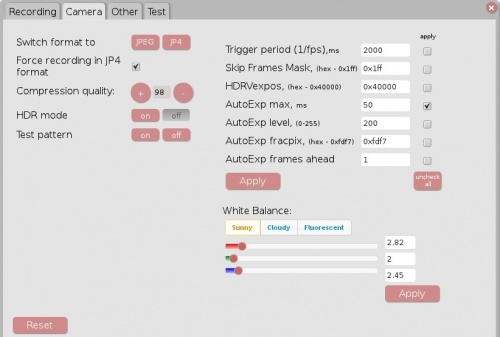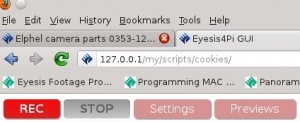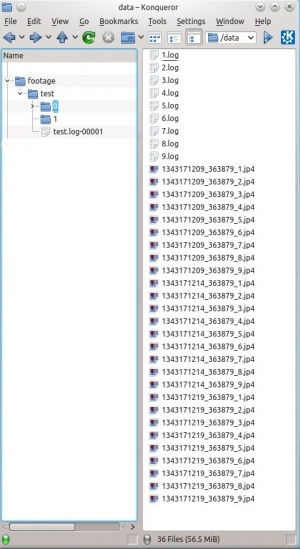Difference between revisions of "Eyesis4Pi 393 User Guide - Recording"
From ElphelWiki
(→Setting recording parameters: camera settings) |
|||
| Line 138: | Line 138: | ||
<font size="2"> | <font size="2"> | ||
| − | '''Trigger period,ms ''' - 1/FPS | + | '''Trigger period,ms ''' - 1/FPS, 200 = 5fps, 250 = 4fps, 500 = 2fps, 1000 = 1fps... |
| − | |||
| − | |||
'''AutoExp max, ms''' - the autoexposure value limit. | '''AutoExp max, ms''' - the autoexposure value limit. | ||
'''AutoExp level''' - value of a pixel at which the autoexposure works. | '''AutoExp level''' - value of a pixel at which the autoexposure works. | ||
| Line 146: | Line 144: | ||
'''AutoExp frame ahead''' - number of previous frames used for calculatin the current frame exposure. | '''AutoExp frame ahead''' - number of previous frames used for calculatin the current frame exposure. | ||
'''Compression quality''' - JP4/JPEG compression quality. | '''Compression quality''' - JP4/JPEG compression quality. | ||
| − | |||
| − | |||
| − | |||
| − | |||
| − | |||
| − | |||
Recommended values for 1 fps: | Recommended values for 1 fps: | ||
'''Trigger period''' = 1000 (ms) | '''Trigger period''' = 1000 (ms) | ||
| − | |||
| − | |||
</font> | </font> | ||
Revision as of 12:30, 16 March 2017
Contents
Download & Install
Install GUI to the device that will be used for recording. There are several ways to install it:
Terminal:
cd <any-path> git clone https://github.com/Elphel/eyesis4pi-393-gui.git git pull (repeat any time to get the latest)
GitHub.com:
https://github.com/Elphel/eyesis4pi-393-gui
Follow the instructions in INSTALL.txt:
1. (For Kubuntu 16.04) Install the following packages, terminal: sudo apt-get install apache2 php5.6 php5.6-curl 2. Make the src folder visible to the web server: 2a. Create a link, terminal: "sudo ln -sf <path-to-eyesis4pi_gui-folder> /var/www/eyesisgui" 2b. Or copy all the files to /var/www/eyesisgui. Note: "/var/www" is the (apache2) web server's document root folder. (for recording to the device over network only) 2c. Make the footage root folder "/data/footage" writable for everyone.
Equipment/Package
- Eyesis4Pi 393
- External SSD enclosure
- Switch
- PC / Laptop
Power On
- Connect the camera's ethernet cables to the switch.
- Power on: switch, SSD enclosure, Eyesis4Pi. Boot takes about 1 min.
Important Notice: Use a fan to cool the camera's pole when shooting indoors.
Network Setup
- Connect the PC to the Gigabit port of the switch.
- Configure the PC's network settings (Kubuntu Network Configuration Guide):
IP address: 192.168.0.68 (example) Mask: 255.255.255.0
Note: Eyesis4Pi 393 default IP addresses: 192.168.0.161-163
Setting recording parameters: camera settings
- Check camera settings at the Settings -> Camera-tab
Trigger period,ms - 1/FPS, 200 = 5fps, 250 = 4fps, 500 = 2fps, 1000 = 1fps... AutoExp max, ms - the autoexposure value limit. AutoExp level - value of a pixel at which the autoexposure works. AutoExp fracpix - number of pixels below the Autoexp level. AutoExp frame ahead - number of previous frames used for calculatin the current frame exposure. Compression quality - JP4/JPEG compression quality.
Recommended values for 1 fps: Trigger period = 1000 (ms)
Recording
- Record-button to start recording
Stopping
- Stop-button for stop.
Downloading IMU/GPS Log
- After stopping - go to the Settings -> Recording-tab to download the IMU/GPS log.
Checking the Recorded Footage
- Check the footage at the Absolute footage path - each panorama set should consist of 9 images named with a timestamp of when it was taken plus the index of the camera (seconds_microseconds_index.jp4):
Note: Missing files most likely means that the FPS is too high.


